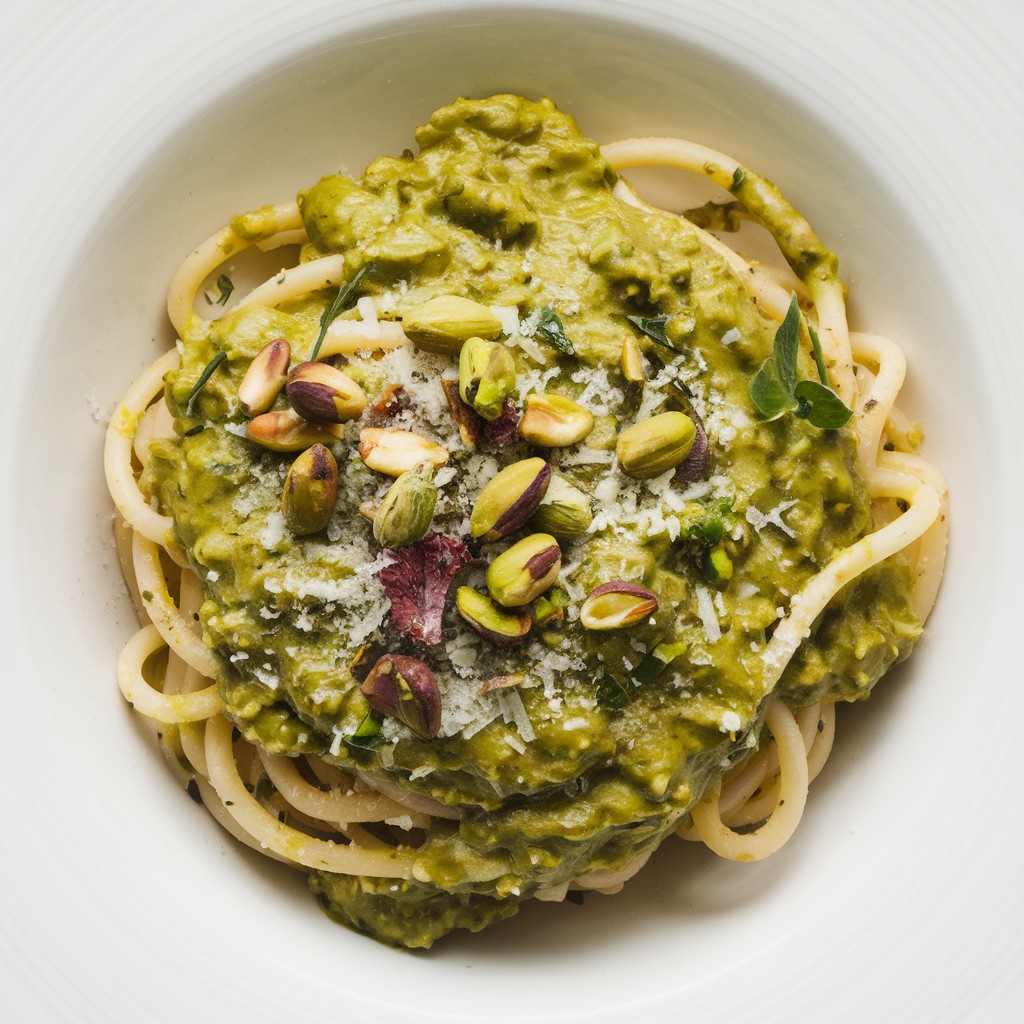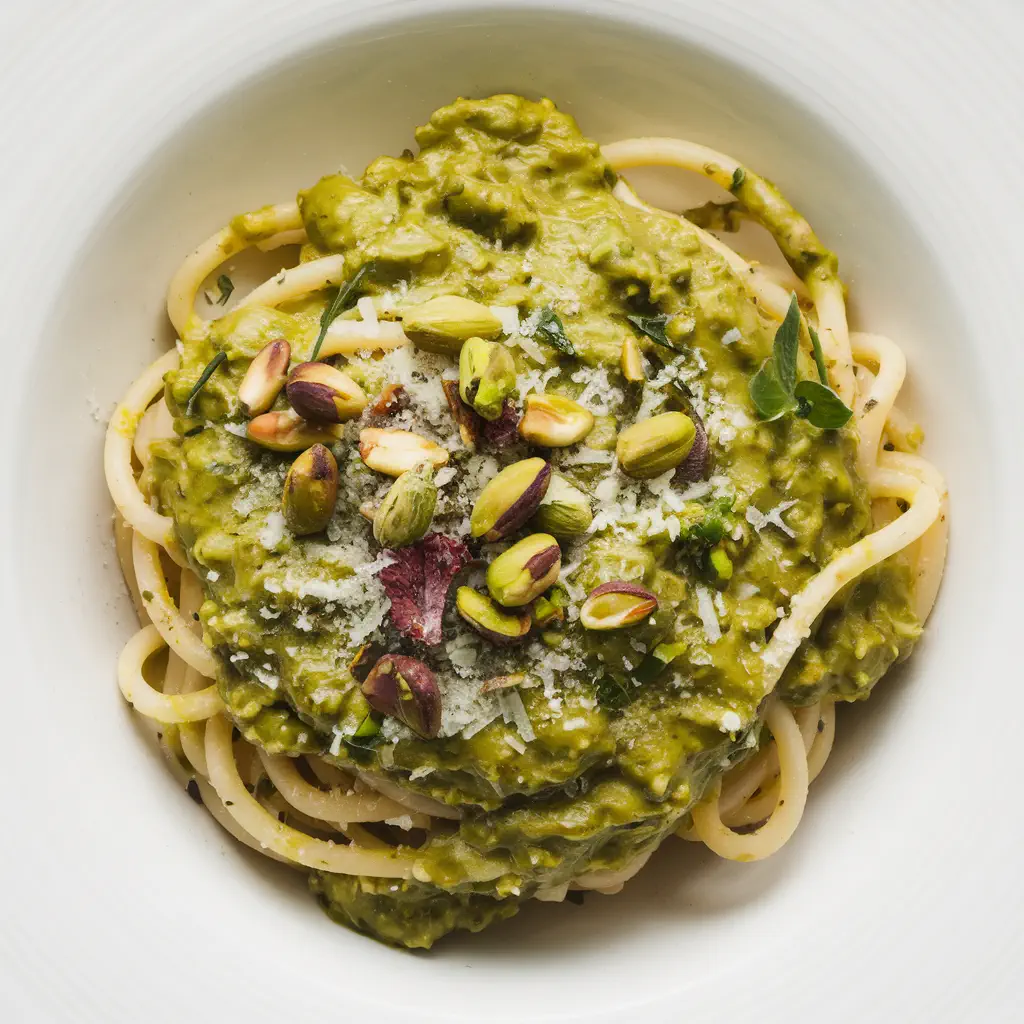
Captivating Introduction
Imagine twirling vibrant green strands of pasta around your fork, each bite bursting with the nutty sweetness of pistachios and a hint of creamy decadence. Forget your usual weeknight dinners; this Pistachio Pasta is a revelation! It’s not just a meal; it’s an experience – a celebration of Italian flavors that will transport you to sun-drenched orchards with every mouthful. Ready to ditch the ordinary and embrace the extraordinary? Let’s dive into this culinary masterpiece!
History and Origin of the Recipe
While Pistachio Pasta isn’t steeped in centuries of tradition like some classic Italian dishes, it’s a modern twist on the country’s love affair with simple, fresh ingredients. Pistachios themselves have been cultivated in the Mediterranean region for millennia, prized for their unique flavor and vibrant color.
Sicily, in particular, is renowned for its exceptional pistachios, especially those from Bronte, known as “green gold.” This recipe draws inspiration from Sicilian cuisine, which often features pistachios in both sweet and savory dishes. The exact origins of Pistachio Pasta are difficult to pinpoint, but it likely emerged from innovative chefs seeking to showcase the pistachio’s versatility and create a memorable pasta experience.
Nutritional Values
Pistachio Pasta isn’t just delicious; it also offers a range of nutritional benefits. Here’s a breakdown of the approximate values per serving (adjustments may vary based on specific ingredients and quantities):
| Nutrient | Amount per Serving |
|---|---|
| Calories | 450-550 |
| Protein | 15-20 g |
| Carbohydrates | 40-50 g |
| Fat | 25-35 g |
| Fiber | 5-7 g |
Key Nutritional Highlights:
- Pistachios: Excellent source of healthy fats, protein, fiber, vitamins (especially B6), and minerals (like copper and manganese).
- Pasta: Provides carbohydrates for energy. Opt for whole-wheat pasta for added fiber and nutrients.
- Olive Oil: Rich in monounsaturated fats, known for their heart-healthy benefits.
- Garlic: Offers antioxidant and anti-inflammatory properties.
- Parmesan Cheese: Adds protein and calcium.
Necessary Equipment
To embark on your Pistachio Pasta adventure, you’ll need the following:
- Food Processor or Blender: For creating the smooth and creamy pistachio sauce.
- Large Pot: For cooking the pasta.
- Skillet or Large Pan : For sautéing garlic and combining the sauce with the pasta.
- Measuring Cups and Spoons: For accurate ingredient measurements
- Colander: For draining the pasta.
- Grater: For grating Parmesan cheese.
- Mixing Bowls: For preparing ingredients.
List of Ingredients with Alternatives
Here’s a comprehensive list of ingredients, along with suggested alternatives to accommodate dietary needs or personal preferences:
Pasta:
- Main: Linguine, spaghetti, or fettuccine (approx. 1 pound)
- Alternatives: Gluten-free pasta, whole-wheat pasta, fresh pasta
Pistachios:
- Main: Shelled, unsalted pistachios (approx. 1 cup)
- Alternatives: Pre-shelled pistachios (if time is short), other nuts (walnuts, almonds – will alter flavor)
Olive Oil:
- Main: Extra virgin olive oil (approx. ¼ cup)
- Alternatives: Regular olive oil, avocado oil
Garlic:
- Main: Fresh garlic cloves (2-3 cloves)
- Alternatives: Garlic powder (approx. ½ teaspoon), jarred minced garlic
Parmesan Cheese:
- Main: Freshly grated Parmesan cheese (approx. ½ cup)
- Alternatives: Pecorino Romano cheese, nutritional yeast (for a vegan option)
Heavy Cream (Optional):
- Main: Heavy cream (approx. ¼ cup) – adds richness
- Alternatives: Crème fraîche, Greek yogurt (for a tangier flavor), cashew cream (for a vegan option)
Lemon Juice:
- Main: Fresh lemon juice (approx. 1 tablespoon) – brightens the flavor
- Alternatives: Bottled lemon juice
Fresh Basil or Parsley:
- Main: Chopped fresh basil or parsley (for garnish)
- Alternatives: Dried basil or parsley
Salt and Black Pepper:
- To taste
Detailed Preparation Steps
Let’s create this Emerald Dream, step-by-step:
1- Prepare the Pistachios: If using raw pistachios, blanch them briefly in boiling water (about 1 minute) to loosen the skins. Drain and rub them in a clean towel to remove as much of the skins as possible. This will help create a smoother, more vibrant green sauce.
2- Toast the Pistachios (Optional): For a deeper flavor, toast the pistachios in a dry skillet over medium heat for 3-5 minutes, until fragrant. Be careful not to burn them.
3- Create the Pistachio Pesto: In a food processor or blender, combine the pistachios, olive oil, garlic, Parmesan cheese (reserving some for garnish), lemon juice, salt, and black pepper. Process until smooth and creamy. If the sauce is too thick, add a tablespoon or two of pasta water to thin it out.
4- Cook the Pasta: Bring a large pot of salted water to a boil. Add the pasta and cook according to package directions until al dente. Reserve about ½ cup of pasta water before draining.
5- Sauté the Garlic (Optional): For a more intense garlic flavor, heat a tablespoon of olive oil in a large skillet over medium heat. Add minced garlic and sauté for about 30 seconds, until fragrant but not browned.
6- Combine Sauce and Pasta: Add the drained pasta to the skillet (or directly to the pot if you didn’t sauté the garlic). Pour the pistachio pesto over the pasta and toss to coat. Add a splash of the reserved pasta water if needed to create a creamy consistency. If using heavy cream, stir it in at this point.
7- Serve: Serve immediately, garnished with extra Parmesan cheese, chopped fresh basil or parsley, and a drizzle of olive oil.
Expert Tips and Tricks
- Quality Matters: Use the best quality pistachios you can find. The flavor of the pistachios will shine through in the sauce, so choose wisely.
- Don’t Overcook the Pasta: Al dente pasta is key to a great texture.
- Taste and Adjust: Taste the sauce before adding it to the pasta and adjust the seasoning as needed. You may want to add more salt, pepper, lemon juice, or Parmesan cheese to suit your preferences.
- Warm Plates: Warm plates help keep the pasta warm while serving.
- Get Creative with Add-Ins: Consider adding grilled chicken, shrimp, or vegetables like asparagus or sun-dried tomatoes to make the dish more substantial.
- For a Vegan Version: Substitute nutritional yeast for Parmesan cheese and use cashew cream instead of heavy cream.
FAQ and Common Problem Resolution
Q: My pistachio sauce is too thick. What do I do?
- A: Add a tablespoon or two of the reserved pasta water to thin it out.
Q: My pistachio sauce is bitter. Why?
- A: Over-processing the pistachios can release bitter compounds. Avoid over-blending. Also, make sure you’ve removed as much of the pistachio skins as possible.
Q: Can I make this ahead of time?
- A: The pistachio sauce can be made a day or two in advance and stored in the refrigerator. However, it’s best to cook the pasta fresh and combine it with the sauce just before serving.
Q: Can I freeze the pistachio sauce?
- A: While you can freeze it, the texture may change slightly upon thawing. It’s best enjoyed fresh.
Q: What if I don’t have a food processor or blender?
- A: You can finely chop the pistachios and garlic and then whisk them together with the other ingredients. The sauce will have a coarser texture, but it will still be delicious.
Variations of the Recipe
Spicy Pistachio Pasta: Add a pinch of red pepper flakes to the sauce for a kick.
Lemon-Pistachio Pasta: Increase the amount of lemon juice for a brighter, more citrusy flavor.
Mint-Pistachio Pasta: Add a handful of fresh mint leaves to the sauce for a refreshing twist.
Pistachio Pesto with Cherry Tomatoes: Roast cherry tomatoes with olive oil, salt, and pepper, and then toss them with the pistachio pasta for a burst of sweetness and acidity.
Pistachio and Arugula Pasta: Add a handful of fresh arugula to the pasta just before serving for a peppery bite.
Pairings and Serving Suggestions
Pistachio Pasta is a versatile dish that pairs well with a variety of accompaniments:
Salad: A simple green salad with a light vinaigrette or a Caprese salad with fresh mozzarella, tomatoes, and basil.
Bread: Crusty bread for soaking up the delicious sauce.
Grilled Vegetables: Grilled asparagus, zucchini, or bell peppers.
Protein: Grilled chicken, shrimp, or fish.
Wine: A crisp white wine like Pinot Grigio or Sauvignon Blanc.
Storage and Freezing
- Storage: Leftover Pistachio Pasta can be stored in an airtight container in the refrigerator for up to 2 days.
- Reheating: Reheat gently in a skillet over low heat, adding a splash of water or broth to prevent it from drying out.
- Freezing: As mentioned earlier, freezing the sauce is possible but not ideal due to potential texture changes.
Testimonials and Reviews
“This Pistachio Pasta is a game-changer! The flavors are so unique and delicious, and it’s surprisingly easy to make.” – Sarah M.
“I made this for a dinner party, and everyone raved about it. It’s definitely a showstopper!” – John B.
“I’m obsessed with pistachios, and this recipe is the perfect way to showcase their flavor. I’ve made it several times, and it’s always a hit.” – Emily K.
Pistachios: A Deep Dive into Green Gold
Let’s take a moment to appreciate the star of our dish: the pistachio!
- Botanical Background: Pistachios are the seeds of the Pistacia vera tree, native to the Middle East and Central Asia.
- Cultivation: The trees thrive in hot, dry climates with well-drained soil. It takes several years for a pistachio tree to begin producing nuts, and they typically bear fruit every other year.
- Harvesting: Pistachios are harvested in the late summer or early autumn when the outer hull splits open, revealing the nut inside.
- Nutritional Powerhouse: As mentioned earlier, pistachios are packed with nutrients, making them a healthy and delicious addition to any diet.
- Culinary Uses: Beyond pasta, pistachios are used in a wide variety of dishes, including desserts, salads, sauces, and snacks.
- Global Production: Iran and the United States (California) are the world’s leading producers of pistachios.
Elevating Your Pistachio Pasta: Culinary Tweaks and Twists
Now that you’ve mastered the basic recipe, let’s explore some more advanced culinary techniques to take your Pistachio Pasta to the next level:
- Homemade Pasta: Making your own pasta from scratch is a labor of love, but it’s well worth the effort. Fresh pasta has a superior texture and flavor compared to store-bought dried pasta.
- Infused Olive Oil: Infuse your olive oil with garlic, herbs, or chili flakes for added depth of flavor.
- Brown Butter Pistachio Sauce: Brown butter adds a nutty, caramelized flavor to the sauce. Simply melt butter in a skillet over medium heat and cook until it turns golden brown and fragrant. Be careful not to burn it.
- Ricotta Salata: Instead of Parmesan cheese, try grating ricotta salata over the pasta. Ricotta salata is a firm, salty cheese that adds a unique flavor and texture.
- Toasted Breadcrumbs: Toasted breadcrumbs add a crunchy element to the dish. Toss breadcrumbs with olive oil, garlic, and herbs, and then toast them in a skillet until golden brown.
- Citrus Zest: Add a pinch of lemon, orange, or grapefruit zest to the sauce for a bright, aromatic flavor.
Pistachio Pasta: A Feast for the Senses
Pistachio Pasta is more than just a meal; it’s a sensory experience. The vibrant green color is visually appealing, the nutty aroma is enticing, and the creamy texture is incredibly satisfying.
The combination of flavors – the sweetness of the pistachios, the sharpness of the Parmesan cheese, the brightness of the lemon juice, and the earthiness of the garlic – creates a harmonious balance that will tantalize your taste buds..
Serving Pistachio Pasta with Style
Presentation is key to creating a memorable dining experience. Here are a few tips for serving your Pistachio Pasta with style:
- Use a Beautiful Bowl: Choose a bowl that complements the vibrant green color of the pasta.
- Garnish Generously: Don’t be shy with the Parmesan cheese, basil or parsley, and olive oil.
- Add a Pop of Color: Consider adding a few edible flowers or a sprig of fresh herbs for an extra touch of elegance.
- Serve with Confidence: Present your dish with pride, knowing that you’ve created a culinary masterpiece.
Why You Should Make Pistachio Pasta Tonight! (A Final Call to Action)
Are you still hesitating? Don’t be! Pistachio Pasta is:
- Easy to Make: Even if you’re a beginner cook, you can master this recipe in under 30 minutes.
- Impressive: It’s a dish that’s sure to impress your family and friends.
- Versatile: It can be adapted to suit your taste preferences and dietary needs.
- Delicious: It’s simply irresistible!
So, what are you waiting for? Gather your ingredients, put on your apron, and prepare to embark on a culinary adventure. Your taste buds will thank you!

